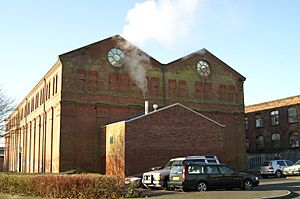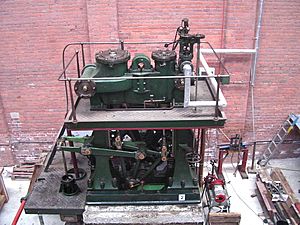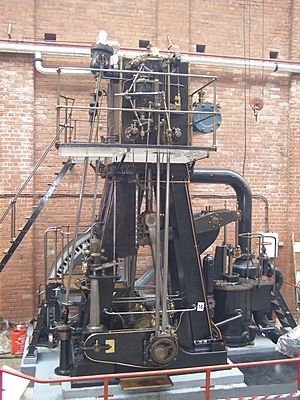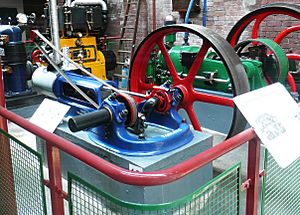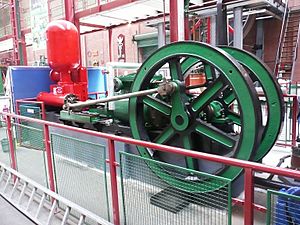Bolton Steam Museum facts for kids
The Bolton Steam Museum is a cool place in Bolton, England. It's filled with amazing old steam engines! These engines used to power factories and machines long ago. The museum is located in an old cotton storage building. It is looked after by a group called the Northern Mill Engine Society (NMES).
Visiting the Museum
The museum is usually open on Wednesdays and Sundays. You can visit between 10 AM and 2 PM. During these times, you can see the engines up close. Volunteers are often working there, so you might see them busy.
Special Open Days
On special Bank Holiday weekends, the museum comes alive! The steam engines are started up and run using real steam power. It's a fantastic chance to see them working. You can also arrange a visit if you are part of a group. Parking is free for museum visitors.
Amazing Steam Engines
Here are some of the cool steam engines you can see at the Bolton Steam Museum. These powerful machines helped run mills and factories in the past.
- Crossfield Mill Beam Engine
- This is a very old engine, made around 1840. It has two large beams that move up and down. It came from the Crossfield Mill in Wardle, Lancashire.
- Wasp Mill Tandem
- This engine was built in 1902 by J & W McNaught Ltd. It's a "tandem compound" engine. This means it has two cylinders in a line. It uses special "Corliss" valves to control the steam. It used to work at the Wasp Mill.
- Parks St Mill NDC
- This unique engine was built in 1893 by John Musgrave and Sons. It's called a "non-dead-centre" engine. It has an interesting design where the cylinders are placed upside down. It came from Park Street Mill.
- Diamond Rope Works
- This engine was built in 1914. It's an "inverted vertical compound" engine. It also uses "Corliss" valves. This engine helped make ropes at Hardman and Ingham's Diamond Rope Works.
- Cellarsclough Beam Engine
- This engine is a "beam engine" that was updated in 1908. It was originally built around 1870. It came from Cellarsclough Mill in Yorkshire.
- Vertical Cross Compound
- This engine was rebuilt in 1900 from older parts. It's a "vertical compound" engine. This means its cylinders are arranged vertically. It has a large flywheel in the middle. It worked at Messrs Kenyon's Dearnside Mills.
- Robey Uniflow
- This is a "Uniflow" engine built in 1926. It's a single-cylinder engine that lies flat. It was first used at the Baltic Sawmills in South Wales.
- Robey Cross Compound
- This engine has two cylinders arranged in a "cross-compound" design. It was built in 1935 by Robey of Lincoln. It was used in the laboratories of the University of Manchester.
- Barraclough Vertical
- This "A-frame" vertical engine was built around 1860. It has a single cylinder. It used to work at Redfearn's Glassworks.
- Chadwick Vertical
- This vertical engine was built by John Chadwick Ltd. It was used to pump water at Cellarsclough Mills.
- Browett & Lindley
- This is a fast-moving engine built in 1900. It's an "inverted vertical" engine. It was connected to an early electric generator. It came from Lakefield Mill.
- Tangye Horizontal
- This engine lies flat and has one cylinder. It was made by Richard Tangye of Birmingham. It came from Vantona Textiles Ltd.
- Langbridge Diagonal
- This engine has two cylinders that are placed diagonally. It was built by Lang Bridge Ironworks. It was used for printing textiles at Bollington Printworks.
- Walker Fire Pump
- This engine is a "rotative fire pump" engine. It was built around 1890 by Walkers of Radcliffe. It was used to pump water in case of a fire at the Fern Mill.
- Barring Engines
- The museum has four different "barring engines." These smaller engines were used to slowly turn the huge mill engines. This helped get them into the right position to start. One of these engines is very special because it came from a mill just a few steps away!
- Other Engines
- You can also see four other smaller steam engines. There are also some oil (diesel) and gas engines. These were made by the National Gas & Oil Engine Co.
See also


